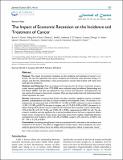The Impact of Economic Recession on the Incidence and Treatment of Cancer

View/
Author
Ennis, Kevin Y.
Chen, Ming-Hui
Smith, Glenna C.
Zhang, Yuanye
Quinn, S. Aidan
Ryemon, Shannon N.
Goltz, Daniel
Harrison, Louis B.
Ennis, Ronald D.
Note: Order does not necessarily reflect citation order of authors.
Published Version
https://doi.org/10.7150/jca.11886Metadata
Show full item recordCitation
Ennis, Kevin Y., Ming-Hui Chen, Glenna C. Smith, Anthony V. D'Amico, Yuanye Zhang, S. Aidan Quinn, Shannon N. Ryemon, Daniel Goltz, Louis B. Harrison, and Ronald D. Ennis. 2015. “The Impact of Economic Recession on the Incidence and Treatment of Cancer.” Journal of Cancer 6 (8): 727-733. doi:10.7150/jca.11886. http://dx.doi.org/10.7150/jca.11886.Abstract
Purpose: The impact of economic recessions on the incidence and treatment of cancer is unknown. We test the hypothesis that cancer incidence and treatment rates decrease during a recession, and that this relationship is more pronounced in cancers that present with mild, more easily ignored symptoms. Methods and Materials: Data on incidence and treatment for all cancers, and breast and pancreatic cancers specifically, from 1973-2008, were collected using Surveillance Epidemiology and End Results (SEER). The data was adjusted for race, income, and education. Unemployment rate was used as the measure of economic recession. Data was log-transformed, and multivariate linear mixed regression was used. Results: Adjusting for socioeconomic factors, the data revealed a significant inverse correlation between unemployment and rates of cancer incidence and treatment. Every 1% increase in unemployment was associated with a 2.2% (95% CI: 1.6-2.8%, p<0.001) reduction in cancer incidence, a 2.0% (1.2-2.8%, p=0.0157) decrease in surgery, and a 9.1% (8.2-10.0% p<0.001) decrease in radiation therapy (RT). Breast cancer incidence and treatment had a dramatic inverse relationship - 7.2% (6.3-8.1%), 6.7% (5.7-7.6%), and 19.0% (18.1-19.8%), respectively (p<0.001 for all). The decrease in incidence was only significant for in situ and localized tumors, but not in regional or distant breast cancer. Compared to breast cancer, pancreatic cancer had a weaker relationship between unemployment and incidence: 2.6% (1.8-3.3%, p=0.0005), surgery: 2.4% (2.0-2.7%, p<0.001), and RT: 1.9% (1.5-2.2% p<0.001). Conclusions: Increasing unemployment rates are associated with a decrease in the incidence and treatment of all cancers. This effect is exaggerated in breast cancer, where symptoms can more easily be ignored and where there are widely used screening tests relative to pancreatic cancer.Other Sources
http://www.ncbi.nlm.nih.gov/pmc/articles/PMC4504108/pdf/Terms of Use
This article is made available under the terms and conditions applicable to Other Posted Material, as set forth at http://nrs.harvard.edu/urn-3:HUL.InstRepos:dash.current.terms-of-use#LAACitable link to this page
http://nrs.harvard.edu/urn-3:HUL.InstRepos:17820931
Collections
- HMS Scholarly Articles [17922]
Contact administrator regarding this item (to report mistakes or request changes)


